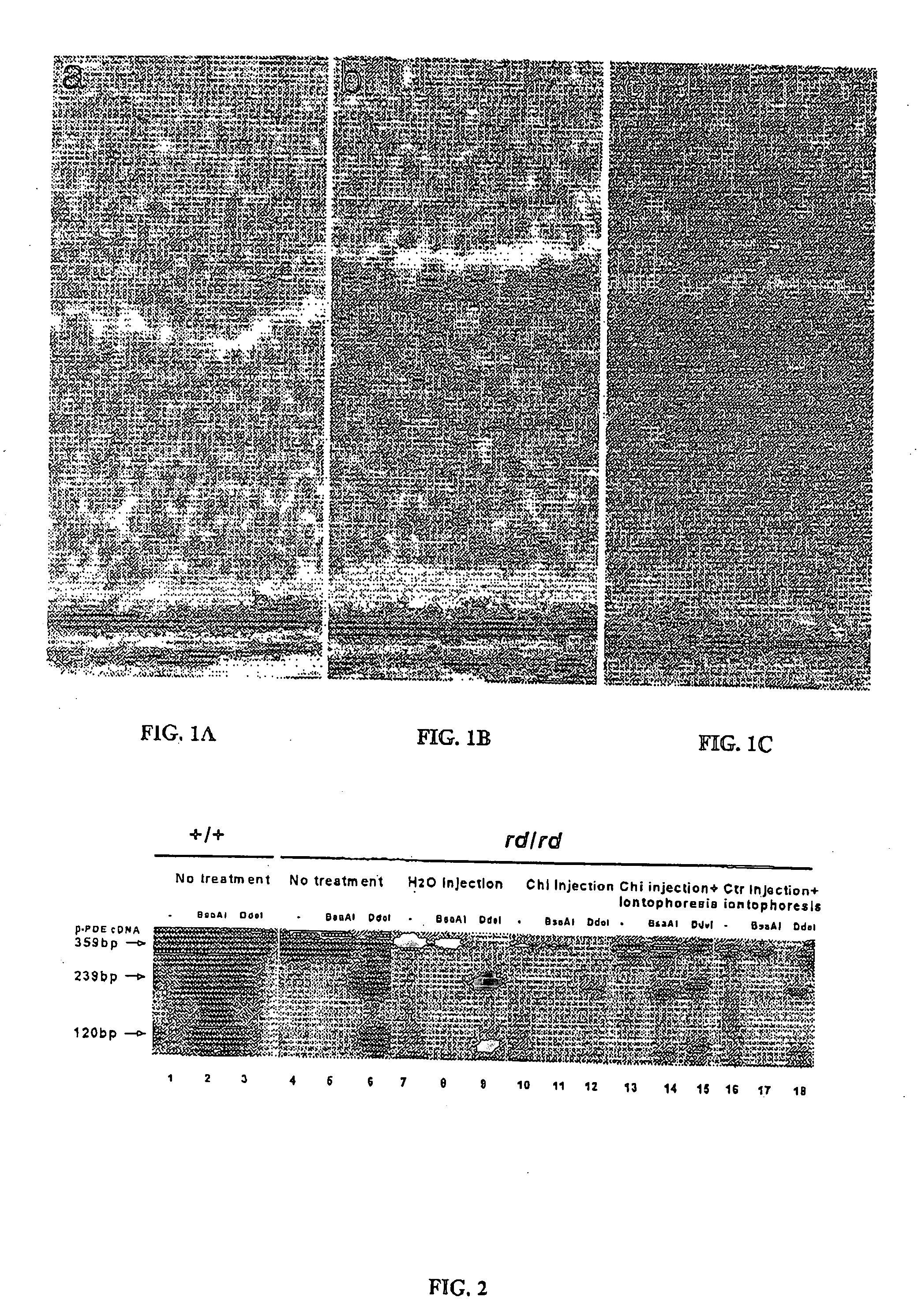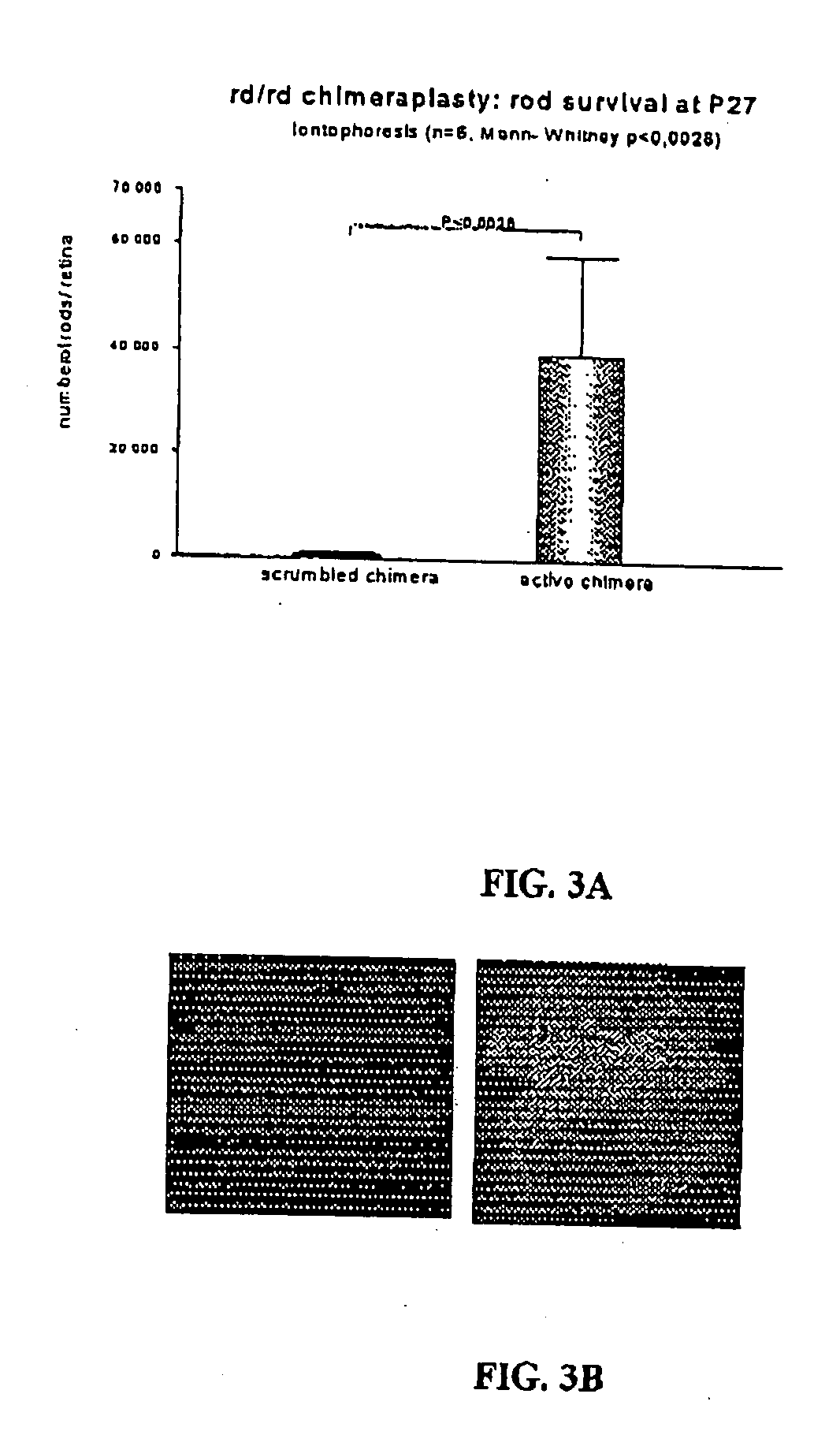Gene therapy with chimeric oligonucleotides delivered by a method comprising a step of iontophoresis
a technology of chimeric oligonucleotides and gene therapy, which is applied in the direction of therapy, drug composition, peptide/protein ingredients, etc., can solve the problems of inability to fully utilize chimeric oligonucleotides, inability to efficiently enhance the penetration of chimeric oligonucleotides into the target, and large volume of molecules transported. , to achieve the effect of simple, efficient and widely used
- Summary
- Abstract
- Description
- Claims
- Application Information
AI Technical Summary
Benefits of technology
Problems solved by technology
Method used
Image
Examples
example i
Treatment of the Retinal Degeneration of the rd Mouse by Iontopherically Transferring in vivo a Chimeric Oligonucleotide into Retina Cells
I: Molecular Basis of the Retinal Degeneration in rd Mice
[0139] Mice homozygous for the rd mutation display hereditary retinal degeneration and serve as a model for human retinitis pigmentosa. In affected animals, the retinal rod photoreceptor cells begin degenerating at about postnatal day 8 and by four weeks no cones are left. Degeneration is preceded by accumulation of cyclic GMP in the retina and is correlated with deficient activity of the rod cGMP-phosphodiesterase. This enzymatical defect is due to the presence of a nonsense C→A mutation in the rd β-PDE gene. The nonsense mutation creates an ochre stop codon (position 347) within exon 7 and leads to the truncation of the resulting cGMP-phosphodiesterase β-subunit. The absence of a functional cGMP-phosphodiesterase protein in rd / rd mice is responsible for retinal degeneration.
[0140] It c...
example ii
Materials and Methods
Materials
[0142] 1) Chimeric Oligonucleotides
[0143] The DNA / 2′OMeRNA chimeric oligonucleotides were synthetisized and purified by high pressure liquid chromatography by GensetOligos (France). The oligonucleotides were resuspended in distilled water and quantitated by ultra-violet absorbance at 260 nm. The sequences of the chimeric (oligonucleotides were are follows:
[0144] Specific chimeric oligonucleotide (named Chi) having the following sequence (sequence SEQ ID No. 1) (the 2′OMe RNA nucleotides are underlined):
5′CCTTCCAACCTACGTAGCAGAAAGTTTTTACUUUCUGCUACGTAGGUUGGAAGGGCGCGTTTTCGCGC 3′
[0145] Control chimeric oligonucleotide (named Ctr) (sequence SEQ ID No. 11) (the 2′OMe RNA nucleotides are underlined):
5′CTACCAAATCCATGGGATTTCCATCAGTTAUUUCUGUCCATCAGGUAGGAGUGGGCTCGCGTGCGTTC 3′
[0146] 2) Animals
[0147] C3H / HeN mice with a nonsense mutation (position 347) were purchased (Iffa Credo). Genotyping to verify the absence or presence of the rd / rd mutation was accomp...
example iii
Results and Discussion
Chimeraplast Design
[0160] Using chimeraplasty rules, a DNA / RNA2′OMe oligonucleotide (named Chi) has been designed which has the potentialities to revert the C→A point mutation located within codon 347 in the mouse rd β-PDE gene. A control oligonucleotide (named Ctr) contains the same base composition as the active chimeric oligonucleotide but a different sequence.
Photoreceptor Transfection by Chimeric Oligonucleotides
[0161] The experiments with the biotinylated oligonucleotide clearly demonstrate that iontophoresis enhances the oligonucleotide uptake in retinal cells, compared to intravitreal injections only as. Notably the uptake in photoreceptors is clearly visible in FIGS. 1A to 1C.
Point Mutation Correction Within rd β-PDE mRNA
[0162] RT-PCR were performed with rd β-PDE mRNA specific primers on extracted retinae. The rd nonsense point mutation in codon 347 creates a DdeI restriction site and removes a BsaAI site from the wild-type sequence. Digesting...
PUM
 Login to View More
Login to View More Abstract
Description
Claims
Application Information
 Login to View More
Login to View More - R&D
- Intellectual Property
- Life Sciences
- Materials
- Tech Scout
- Unparalleled Data Quality
- Higher Quality Content
- 60% Fewer Hallucinations
Browse by: Latest US Patents, China's latest patents, Technical Efficacy Thesaurus, Application Domain, Technology Topic, Popular Technical Reports.
© 2025 PatSnap. All rights reserved.Legal|Privacy policy|Modern Slavery Act Transparency Statement|Sitemap|About US| Contact US: help@patsnap.com


